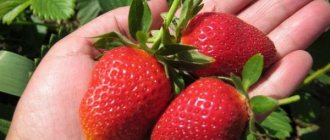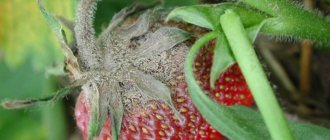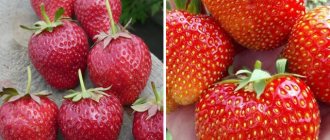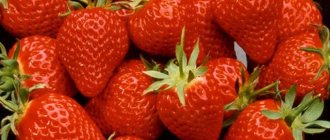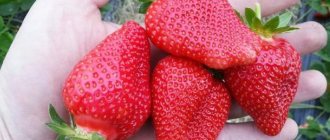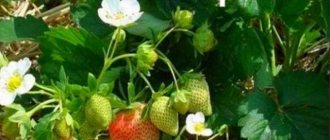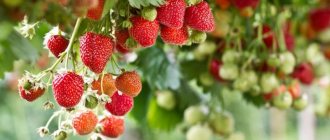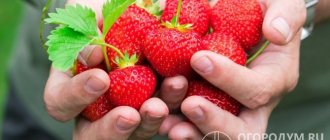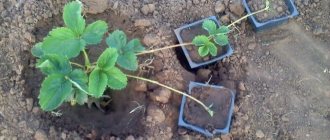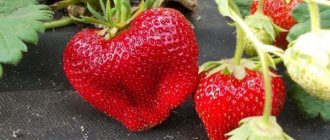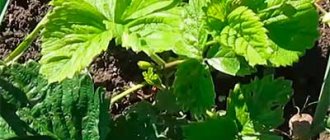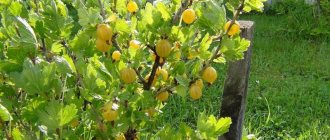Vima Xima's strawberries have made a gardener's dream come true - to collect a large bucket of sweet, fragrant berries in 10 minutes. However, the mid-late variety, bred by Dutch breeders, is causing a lot of controversy. We will collect the bucket, but what to do with it if the fruits have no taste and aroma, and are similar in hardness to apples? There are many opinions and diametrically opposed opinions: enthusiastic reviews alternate with negative ones. Let's try to figure it out what's the matter.
Description of the variety
Vima Xima is a non-repairing variety of strawberry, late or mid-late fruiting. Of the currently known varieties of garden strawberries, it is one of the largest-fruited and most productive. Shows good adaptation in regions with a temperate continental climate.
The variety is ideal for temperate climates. In the south, as in the north, reviews of the taste of berries are mostly negative
Bushes
The powerful bushes of Vim Xima cannot be called compact. The variety is distinguished by the characteristic green-gray color of the leaves. The shape of the foliage is large, slightly ribbed and wrinkled. Thick flower stalks do not grow higher than the foliage. When there is a large harvest, they tend to the ground.
The tendril-forming ability is weak, the tendrils do not have to be cut off often, but their quantity may not be enough to propagate the variety even in a garden plot. It is important to know the specifics of the culture and think through the renewal scheme in advance. The fact is that young bushes produce the maximum number of whiskers in the first year of their development. If you don’t think about updating the plantation for the first few years, then in the third year you may not get the required number of mustaches. Therefore, it is important to separate the mother plants to obtain seedlings and the fruiting beds, in which all the tendrils will be removed.
Every 2-3 years, Vim Xima plantations are renewed. Otherwise, not only productivity decreases, but also immunity to disease
Berries
In the first year, you should not expect giant berries to bear fruit, but in the second and third years, with proper agricultural technology, you can get beautiful specimens weighing up to 100-120 g. The bulk of the fruits will have an average weight of about 40-50 g. The shape of the fruits is round, blunt-conical , sometimes comb-shaped. The surface of the berries is dark red and glossy.
The pulp is juicy and dense. Vima Xima handles transportation very well. The main thing is to pick the berries 2-3 days before final ripening and place them one row in a cardboard box. Tasters rate the taste at 4.6 points.
They eat Vima Xima strawberries fresh, freeze them, make compotes and jams
Productivity
Ripening of Vima Xima garden strawberries begins in mid-to-late July. The duration depends on the climate, weather, and agricultural technology. 6-8 waves of harvest are spread over about a month. Yield rates vary greatly among growing regions. 400-900 g per bush is a common productivity indicator in private gardens.
In central Russia, the results of state tests showed 145 c/ha. In Belarus, it was possible to collect 67.4 centners per hectare on one plantation, and 171 centners per hectare in another nursery. This variation in productivity partly explains the conflicting reviews from gardeners.
Strawberry Vima Rina
Also check out these articles
- David Austin Roses
- Why do cucumber leaves turn yellow?
- Potato variety Zest
- Katum sheep
Photo of strawberries by Vima Rina
The Vima Rina variety was developed completely by accident, when pollinating the remontant strawberry Selva. It is of medium late ripening type. The bushes of this type are semi-spreading and have many leaves. Leaves with pronounced ribs, light green in color. Whiskers grow only in small numbers. Peduncles are located equally with the leaves. The buds are always white and medium in size.
Fruits grow 45 g on average. They are in the form of a cone, with a distinguishable neck. The color is dark scarlet, the skin is glossy. The flesh is elastic and tender. The taste of strawberries is very pleasant, 4.8 points out of 5 possible, according to tasters. The aroma is strong.
The Vima Rina strawberry variety has good frost resistance and average drought resistance. The yield from 1 bush per season reaches 800 g. The berries are suitable for long-term transportation, they have a universal purpose.
a brief description of
Vima Xima is an interesting variety that will not leave the gardener indifferent. It will delight you with gorgeous large tasty fruits, or it will turn into a medium-sized fresh berry. It all depends on the weather and agricultural technology.
Advantages of the variety
- high yield under favorable conditions;
- suitable for cultivation on different soils;
- classical agricultural technology for strawberries;
- large berries for 2-3 seasons;
- the berries are one-dimensional, have an excellent presentation, shine, and beautiful color;
- the crop is stored for a long time, long-term transportation is possible;
- high winter hardiness;
- immune to white spotting, little susceptible to powdery mildew.
Disadvantages of the variety
- after 3 years the bushes age and sharply lose productivity;
- Strawberries can die from heat and drought; they need regular watering, and the taste of the berries deteriorates;
- timely prevention from diseases and pests is required;
- in the rainy season with few sunny days, the berry will be watery, tasteless, and practically without aroma;
- bushes react very poorly to thickening - the berries rot;
- with a lack of fertilizing, the quality of the berries deteriorates;
- Not suitable for all growing regions.
This extremely long list of shortcomings can be significantly shortened with the right agricultural technology, but if we are talking about stability in terms of taste and aroma, then it is better to opt for some other variety.
Landing
Planting young Vima Xima strawberry seedlings with a closed root system can be done throughout the season, but it is better at the end of July or early August. The seedlings will have time not only to take root, but also to develop and lay flower buds in order to produce a good harvest for the next season.
You should not place strawberries in a damp, dark corner of the garden. It is recommended to choose flat, dry, sunny areas that are convenient for regular watering and fertilizing.
Strawberries will grow equally well on loam and sandy loam. When preparing the soil, it should be refined. Dilute the clayey one with sand, the acidic one with lime, dolomite flour or ash, and add an increased rate of manure to the too loose one. Average values for fertilizing: a bucket of rotted manure and a glass of ash per 1 m2 of berry garden.
The Xima planting scheme has a peculiarity: it is strictly forbidden to thicken the plantation; the bushes may disappear during periods of prolonged rains. A distance of at least 35-40 cm is left between seedlings, 50-60 cm between rows. Immediately after planting, strawberry bushes should be sprayed with a cherry solution of potassium permanganate. This procedure will increase immunity and serve as a good prevention against possible infection with diseases.
Peduncles of young Vima Xima seedlings should be removed in the first year. The seedlings will take root better and there will be more berries next year.
Reviews about the strawberry variety Vima
Varieties from the Vima series are known to many farmers. Vima strawberries can be used for cultivation both on large plantations and on small, private lands.
- Roman Puzik : “Vim Zant’s strawberries are good in all respects. Its main drawback is that the crop cannot be transported over long distances; it gets wrinkled on the road. Otherwise the variety is very pleasing. The berries are one-dimensional, large, and come off the stalk without any problems. Regular, painstaking care is needed, but this is the same with any type of strawberry - you can get a big harvest only by investing a lot of effort and time.”
- Maria Kulish : “I chose the Xima variety based on reviews and recommendations from friends. I have been growing these strawberries for more than 2 years. Pleases with large yields and rich, sweet, juicy taste. The bushes haven’t suffered from anything in two years, but 1-2 times a year I do preventive treatments with broad-spectrum fungicides and insecticides, maybe that’s the problem.”
- Oksana Koroleva : “A year ago I decided to update the strawberry bed with a new variety. I randomly ordered the Vima Kimberly variety of strawberries. The bushes grew quickly, and responded normally to the summer heat and even dry wood for 3 weeks in July. The harvest was more than worthy - the berries were large, tasty, beautiful, and could be sent to an exhibition! But for the winter I insulate it, just in case, it would be too much of a shame to lose such good bushes.”
Growing and care
Watering
Vima Xima does not tolerate drought well. To prevent the taste from deteriorating and the yield from decreasing, garden strawberries must be provided with regular watering. There is also no need to overdo it; with high humidity there will be a risk of infection with gray rot and other diseases. During rainy seasons, most of the crop may be lost. The best way out of this situation is to organize drip irrigation and a rare planting scheme.
Vima Xima ripens about 2 weeks later than another popular garden strawberry variety, Elsanta.
Loosening, weed control
Cultivated plants do not tolerate proximity to weeds, and Vima Xima strawberries especially. Weeds shade strawberries, take away beneficial microelements from the soil, and serve as a breeding ground for diseases. Weeds interfere with ventilation, which leads to the development of gray rot. Regular weeding and loosening of strawberry beds guarantees a good harvest.
Removing a mustache
Vima Xima doesn't have a lot of mustaches. Monitoring shoot formation is not difficult. The mustache is thick and powerful. Trim them with sharp scissors or pruning shears, leaving a stump of about 2 cm.
Top dressing
The first feeding of Vima Xima strawberries is carried out in early spring. Mullein is bred in a ratio of 1:10. 0.5 liter is enough per bush. solution. During the formation of ovaries, mineral fertilizing is carried out with nitrophoska. (40 g per bucket of water).
Fertilizing with May nettle infusion gives good results. Chopped nettles are poured into a bucket two-thirds full with water and allowed to brew for about a week. Consumption per bush - 1 liter of infusion diluted 1:10. In summer, watering can be combined with fertilizing with wood ash.
Disease and pest control
During testing, the Vima Xima variety showed resistance to fungal diseases and resists spotting. Berries can be attacked by weevils, strawberry mites and wasps. For prevention, spray the plant with infusions of garlic or onion peels. When cultivated on an industrial scale, fungicides are used for treatment.
Farmers practice growing the Vima Xima variety in a two-year cycle to get maximum yield and reduce the number of treatments.
Preparing for winter
Vima Xima is a winter-hardy variety that tolerates frost well under the snow. In cold areas with little snow cover, strawberries are covered with agrofibre or organic mulch.
Reproduction
The Vima Xima strawberry is propagated by a mustache or by dividing the bush. Leave first and second order sockets. After rooting, the tendrils are cut off and the plant is transplanted to a permanent location.
When dividing the bush, you must ensure that the flower stalks are not damaged. The best planting material is a three-year-old bush with a branched root system.
Reviews
Every spring it seems that Vima Xima has frozen out for me. The remaining varieties: Honey, Zenga Zengana, Vima Zanta are already green, and Xima barely begins to produce leaves, however, then quickly catches up with its neighbors and, thanks to its resistance to diseases and pests, stands green and beautiful. The berries are very large to gain 1 kg. You literally need 20 berries. For the conditions of the Moscow region, the variety is well suited, the yield is high, the berries are tasty. I gave seedlings to relatives in Sevastopol, they say that the berries bake hard and taste sour.
Vima Xima is a late variety, which is why I don’t like it. You want to eat strawberries in early June, when there are no berries yet, and then raspberries, blackberries, and cherries begin to turn red, and there is no longer such a shortage of berries.
In Russia, the Vima Xima strawberry appeared recently, although it was bred in the 80s of the last century. The state registry has approved it for landing in the Central region.
Strawberry by Wim Tarda
We recommend reading our other articles
- Watermelon Ogonyok
- Mineral fertilizers
- Advantages of frame houses
- Horse management
Photo of strawberries by Wim Tarda
The Vima Tarda variety was obtained by crossing the Vima Zanta and Vikonda varieties. The ripening period is the latest of all Vim varieties. The bushes are vigorous. There are a lot of leaves, they are dark green and shiny. A lot of whiskers are formed, which is convenient for reproduction. Peduncles are located at the level of leaflets or below. The flowers are white, medium in size.
The berries are large, without emptiness inside, rounded. The color is dark cherry, the skin is glossy. The flesh is elastic, scarlet. The taste of the fruit is sweet, the aroma is delicate.
Interesting!
Wim Tarda strawberries can be stored for a long time due to the fact that the berries are elastic and do not contain voids inside. However, in terms of taste, this variety is inferior to other varieties of Vim.
The yield of the Vima Tarda strawberry variety is 600g/bush per season. The plant's winter hardiness is high, drought resistance is average. The plant has developed immunity to many diseases. The crop is suitable for long-term transportation. The purpose is universal.
